Making Intangibles Tangible: Identifying Manifestations of Cultural Ecosystem Services in a Cultural Landscape
Abstract
1. Introduction
2. Methods and Materials
2.1. Approach
2.2. Study Area
3. Case Study
3.1. A Brief History about Human Activities around the Weser
3.2. Identifying Potential Manifestations
3.2.1. Physical and Experiential Use
3.2.2. Science and Education
3.2.3. Cultural Heritage
3.2.4. Entertainment and Inspiration
3.2.5. Symbol
3.2.6. Sacredness and Religiousness
3.3. Searching for Concrete Manifestations
3.3.1. Physical Use
3.3.2. Experiential Use
3.3.3. Science and Education
3.3.4. Cultural Heritage
3.3.5. Entertainment
3.3.6. Inspiration
3.3.7. Symbol
3.3.8. Sacredness and Religiousness
4. Discussion
4.1. Limitations and Advantages of This Approach
4.2. Implications for Future Research
5. Conclusions
Author Contributions
Funding
Acknowledgments
Conflicts of Interest
References
- TEEB. Mainstreaming the Economics of Nature: A Synthesis of the Approach, Conclusions and Recommendations of TEEB. 2010. Available online: http://teebweb.org/publications/teeb-for/synthesis/ (accessed on 15 December 2021).
- Costanza, R.; De Groot, R.; Braat, L.; Kubiszewski, I.; Fioramonti, L.; Sutton, P.; Farber, S.; Grasso, M. Twenty years of ecosystem services: How far have we come and how far do we still need to go? Ecosyst. Serv. 2017, 28, 1–16. [Google Scholar] [CrossRef]
- Cheng, X.; Van Damme, S.; Li, L.; Uyttenhove, P. Evaluation of cultural ecosystem services: A review of methods. Ecosyst. Serv. 2019, 37, 100925. [Google Scholar] [CrossRef]
- Sumarga, E.; Hein, L.; Edens, B.; Suwarno, A. Mapping monetary values of ecosystem services in support of developing ecosystem accounts. Ecosyst. Serv. 2015, 12, 71–83. [Google Scholar] [CrossRef]
- Van Berkel, D.B.; Verburg, P.H. Spatial quantification and valuation of cultural ecosystem services in an agricultural landscape. Ecol. Indic. 2014, 37, 163–174. [Google Scholar] [CrossRef]
- Garcia, X.; Corominas, L.; Pargament, D.; Acuña, V. Is river rehabilitation economically viable in water-scarce basins? Environ. Sci. Policy 2016, 61, 154–164. [Google Scholar] [CrossRef]
- Kenter, J.O. Integrating deliberative monetary valuation, systems modelling and participatory mapping to assess shared values of ecosystem services. Ecosyst. Serv. 2016, 21, 291–307. [Google Scholar] [CrossRef]
- Gandarillas, R.V.; Jiang, Y.; Irvine, K. Assessing the services of high mountain wetlands in tropical Andes: A case study of Caripe wetlands at Bolivian Altiplano. Ecosyst. Serv. 2016, 19, 51–64. [Google Scholar] [CrossRef]
- Ungaro, F.; Häfner, K.; Zasada, I.; Piorr, A. Mapping cultural ecosystem services: Connecting visual landscape quality to cost estimations for enhanced services provision. Land Use Policy 2016, 54, 399–412. [Google Scholar] [CrossRef]
- Unnikrishnan, H.; Nagendra, H. Privatizing the commons: Impact on ecosystem services in Bangalore’s lakes. Urban Ecosyst. 2015, 18, 613–632. [Google Scholar] [CrossRef]
- Everard, M.; Jones, L.; Watts, B. Have we neglected the societal importance of sand dunes? An ecosystem services perspective. Aquat. Conserv. Mar. Freshw. Ecosyst. 2010, 20, 476–487. [Google Scholar] [CrossRef]
- Willemen, L.; Cottam, A.J.; Drakou, E.; Burgess, N.D. Using Social Media to Measure the Contribution of Red List Species to the Nature-Based Tourism Potential of African Protected Areas. PLoS ONE 2015, 10, e0129785. [Google Scholar] [CrossRef] [PubMed]
- Schmidt, K.; Walz, A.; Jones, I.; Metzger, M.J. The Sociocultural Value of Upland Regions in the Vicinity of Cities in Comparison With Urban Green Spaces. Mt. Res. Dev. 2016, 36, 465–474. [Google Scholar] [CrossRef]
- Bryce, R.; Irvine, K.N.; Church, A.; Fish, R.; Ranger, S.; Kenter, J.O. Subjective well-being indicators for large-scale assessment of cultural ecosystem services. Ecosyst. Serv. 2016, 21, 258–269. [Google Scholar] [CrossRef]
- Bieling, C. Cultural ecosystem services as revealed through short stories from residents of the Swabian Alb (Germany). Ecosyst. Serv. 2014, 8, 207–215. [Google Scholar] [CrossRef]
- Ondiek, R.A.; Kitaka, N.; Oduor, S.O. Assessment of provisioning and cultural ecosystem services in natural wetlands and rice fields in Kano floodplain, Kenya. Ecosyst. Serv. 2016, 21, 166–173. [Google Scholar] [CrossRef]
- Nahuelhual, L.; Carmona, A.; Lozada, P.; Jaramillo, A.; Aguayo, M. Mapping recreation and ecotourism as a cultural ecosystem service: An application at the local level in Southern Chile. Appl. Geogr. 2013, 40, 71–82. [Google Scholar] [CrossRef]
- MacDonald, P.A.; Murray, G.; Patterson, M. Considering social values in the seafood sector using the Q-method. Mar. Policy 2015, 52, 68–76. [Google Scholar] [CrossRef]
- Brown, G.; Raymond, C. The relationship between place attachment and landscape values: Toward mapping place attachment. Appl. Geogr. 2007, 27, 89–111. [Google Scholar] [CrossRef]
- Darvill, R.; Lindo, Z. Quantifying and mapping ecosystem service use across stakeholder groups: Implications for conservation with priorities for cultural values. Ecosyst. Serv. 2015, 13, 153–161. [Google Scholar] [CrossRef]
- Brown, G.; Hausner, V.H. An empirical analysis of cultural ecosystem values in coastal landscapes. Ocean Coast. Manag. 2017, 142, 49–60. [Google Scholar] [CrossRef]
- Hassan, R.; Scholes, R.; Ash, N. Ecosystems and Human Well-Being: Current State and Trends; Island Press: Washington, DC, USA, 2005. [Google Scholar]
- Comberti, C.; Thornton, T.F.; Wyllie de Echeverria, V.; Patterson, T. Ecosystem services or services to ecosystems? Valuing cultivation and reciprocal relationships between humans and ecosystems. Glob. Environ. Chang. 2015, 34, 247–262. [Google Scholar] [CrossRef]
- Sangha, K.K.; Evans, J.; Edwards, A.; Russell-Smith, J.; Fisher, R.; Yates, C.; Costanza, R. Assessing the value of ecosystem services delivered by prescribed fire management in Australian tropical savannas. Ecosyst. Serv. 2021, 51, 101343. [Google Scholar] [CrossRef]
- Dawson, N.M.; Coolsaet, B.; Sterling, E.J.; Loveridge, R.; Gross-Camp, N.D.; Wongbusarakum, S.; Sangha, K.K.; Scherl, L.M.; Phan, H.P.; Zafra-Calvo, N.; et al. The role of Indigenous peoples and local communities in effective and equitable conservation. Ecol. Soc. 2021, 26, 19. [Google Scholar] [CrossRef]
- Sangha, K.K.; Preece, L.; Villarreal-Rosas, J.; Kegamba, J.J.; Paudyal, K.; Warmenhoven, T.; RamaKrishnan, P.S. An ecosystem services framework to evaluate indigenous and local peoples’ connections with nature. Ecosyst. Serv. 2018, 31, 111–125. [Google Scholar] [CrossRef]
- Sangha, K.K.; Russell-Smith, J.; Costanza, R. Mainstreaming indigenous and local communities’ connections with nature for policy decision-making. Glob. Ecol. Conserv. 2019, 19, e00668. [Google Scholar] [CrossRef]
- Stoeckl, N.; Jarvis, D.; Larson, S.; Larson, A.; Grainger, D.; Corporation, E.A. Australian Indigenous insights into ecosystem services: Beyond services towards connectedness—People, place and time. Ecosyst. Serv. 2021, 50, 101341. [Google Scholar] [CrossRef]
- Plieninger, T.; van der Horst, D.; Schleyer, C.; Bieling, C. Sustaining ecosystem services in cultural landscapes. Ecol. Soc. 2014, 19, 59. [Google Scholar] [CrossRef]
- Pinheiro, R.O.; Triest, L.; Lopes, P.F.M. Cultural ecosystem services: Linking landscape and social attributes to ecotourism in protected areas. Ecosyst. Serv. 2021, 50, 101340. [Google Scholar] [CrossRef]
- Bieling, C.; Plieninger, T. Recording Manifestations of Cultural Ecosystem Services in the Landscape. Landsc. Res. 2013, 38, 649–667. [Google Scholar] [CrossRef]
- Coscieme, L. Cultural ecosystem services: The inspirational value of ecosystems in popular music. Ecosyst. Serv. 2015, 16, 121–124. [Google Scholar] [CrossRef]
- Figueroa-Alfaro, R.W.; Tang, Z. Evaluating the aesthetic value of cultural ecosystem services by mapping geo-tagged photographs from social media data on Panoramio and Flickr. J. Environ. Plan. Manag. 2017, 60, 266–281. [Google Scholar] [CrossRef]
- Hutcheson, W.; Hoagland, P.; Jin, D. Valuing environmental education as a cultural ecosystem service at Hudson River Park. Ecosyst. Serv. 2018, 31, 387–394. [Google Scholar] [CrossRef]
- Hiron, M.; Pärt, T.; Siriwardena, G.M.; Whittingham, M.J. Species contributions to single biodiversity values under-estimate whole community contribution to a wider range of values to society. Sci. Rep. 2018, 8, 7004. [Google Scholar] [CrossRef]
- Katayama, N.; Baba, Y.G. Measuring artistic inspiration drawn from ecosystems and biodiversity: A case study of old children’s songs in Japan. Ecosyst. Serv. 2020, 43, 101116. [Google Scholar] [CrossRef]
- Jiang, W.; Marggraf, R. Ecosystems in Books: Evaluating the Inspirational Service of the Weser River in Germany. Land 2021, 10, 669. [Google Scholar] [CrossRef]
- Lansing, J.S.; Lansing, P.S.; Erazo, J.S. The Value of a River. J. Political Ecol. 1998, 5, 1–22. [Google Scholar] [CrossRef][Green Version]
- Haines-Young, R.; Potschin, M.B. Common International Classification of Ecosystem Services (CICES) V5.1 and Guidance on the Application of the Revised Structure. 2018. Available online: https://cices.eu/content/uploads/sites/8/2018/01/Guidance-V51-01012018.pdf (accessed on 15 August 2021).
- Below, M. Die Weser. Vom Thüringer Wald Bis Zur Nordsee; Temmen: Bremen, Germany, 2011. [Google Scholar]
- Küster, B. Die Weser: 1800–2000; Donat: Bremen, Germany, 1999. [Google Scholar]
- Löbe, K. Das Weserbuch. Roman Eines Flusses. 2. Aufl.; Niemeyer: Hameln, Germany, 1969. [Google Scholar]
- Braun, H.-G.; Eckoldt, M.; Rohde, H. Die Weser. In Flüsse und Kanäle. Die Geschichte der Deutschen Wasserstrassen; Martin, E., Hans-Georg, B., Eds.; DSV-Verl.: Hamburg, Germany; Busse-Seewald: Herford, Germany, 1998. [Google Scholar]
- Gee, K.; Burkhard, B. Cultural ecosystem services in the context of offshore wind farming: A case study from the west coast of Schleswig-Holstein. Ecol. Complex. 2010, 7, 349–358. [Google Scholar] [CrossRef]
- Alexander, E.P. Museums in Motion. An Introduction to the History and Functions of Museums; American Association for State and Local History: Nashville, TN, USA, 1979. [Google Scholar]
- Millennium Ecosystem Assessment. Ecosystems and Human Well-Being: Synthesis; Island Press: Washington, DC, USA, 2005. [Google Scholar]
- United Nations Educational, Scientific and Cultural Organization. Convention Concerning the Protection of the World Cultural and Natural Heritage. Adopted by the General Conference at Its Seventeenth Session Paris, 16 November 1972. Paris. 1972. Available online: http://whc.unesco.org/archive/convention-en.pdf (accessed on 15 August 2021).
- Daniel, T.C.; Muhar, A.; Arnberger, A.; Aznar, O.; Boyd, J.W.; Chan, K.M.A.; Costanza, R.; Elmqvist, T.; Flint, C.G.; Gobster, P.H.; et al. Contributions of cultural services to the ecosystem services agenda. Proc. Natl. Acad. Sci. USA 2012, 109, 8812–8819. [Google Scholar] [CrossRef]
- Allgemeiner Deutscher Fahrrad-Club. Bicycle Travel Analysis. 2016. Available online: https://www.adfc.de/fileadmin/user_upload/Expertenbereich/Touristik_und_Hotellerie/Radreiseanalyse/Downloads/ADFC_Bicycle_Travel_Analysis__2016__engl._short_version_.pdf (accessed on 15 December 2021).
- Bielefelder Verlag. Weser-Radweg: Vom Weserbergland Bis zur Nordsee. Radwanderkarte 1:75.000. 3. Aufl.; Bielefelder Verlag: Bielefeld, Germany, 2013. [Google Scholar]
- Großmann, G.U. Renaissance im Weserraum; Dt. Kunstverl: München, Germany, 1989. [Google Scholar]
- Paetow, K. Die Schönsten Wesersagen. 3., Durchges. und Erw. Aufl.; Sponholtz: Hameln, Germany, 1974. [Google Scholar]
- von Dingelstedt, F. Das Wesertal von Münden bis Minden. Reprograf. Nachdr. der Ausg. Kassel und Leipzig 1838; Olms: Hildesheim, Germany, 1972. [Google Scholar]
- Raabe, W. Der heilige Born; Vandenhoeck & Ruprecht: Göttingen, Germany, 1968. [Google Scholar]
- Strack, A.W.; Albrecht, T. Malerische Reise Durch das Weserbergland: Anton Wilhelm Strack, Hofmaler und Professor für Zeichenkunst in Bückeburg (1758–1829); Verl. Createam: Bückeburg, Germany, 1997. [Google Scholar]
- Kastler, J.; Lüpkes, V. (Eds.) Die Weser. EinFluss in Europa. Aufbruch in die Neuzeit; Mitzkat (Die Weser-Einfluss in Europa, Bd. 2): Holzminden, Germany, 2000. [Google Scholar]
- Musculus, J.C.; Eckhardt, A. Der Deichatlas des Johann Conrad Musculus von 1625/26. Faks; Holzberg: Oldenburg, Germany, 1985. [Google Scholar]
- Stadler, K. Die Gemeindewappen der Bundesländer Niedersachsen und Schleswig-Holstein; Angelsachsen-Verl.: Bremen, Germany, 1970. [Google Scholar]
- Veddeler, P. Wappen, Siegel, Flaggen. Die kommunalen Hoheitszeichen des Landschaftsverbandes, der Kreise, Städte und Gemeinden in Westfalen-Lippe; Ardey: Münster, Germany, 2003. [Google Scholar]
- Hildebrandt, A.M. Handbuch der Heraldik. 19., Verb. und Erw. Aufl.; Nikol: Hamburg, Germany, 2007. [Google Scholar]
- Taylor, B.R. The Encyclopedia of Religion and Nature; Thoemmes Continuum: London, UK, 2005. [Google Scholar]
- Engel, A. Weserbuch. Ein erklärender Begleiter auf der Weserreise mit Berücksichtigung der Fulda von Kassel ab. Repr. d. Ausg.; Niemeyer: Hameln, Germany, 1990. [Google Scholar]
- Hernández-Morcillo, M.; Plieninger, T.; Bieling, C. An empirical review of cultural ecosystem service indicators. Ecol. Indic. 2013, 29, 434–444. [Google Scholar] [CrossRef]
- Ridding, L.E.; Redhead, J.W.; Oliver, T.H.; Schmucki, R.; McGinlay, J.; Graves, A.R.; Morris, J.; Bradbury, R.B.; King, H.; Bullock, J.M. The importance of landscape characteristics for the delivery of cultural ecosystem services. J. Environ. Manag. 2018, 206, 1145–1154. [Google Scholar] [CrossRef]
- Thiele, J.; Albert, C.; Hermes, J.; von Haaren, C. Assessing and quantifying offered cultural ecosystem services of German river landscapes. Ecosyst. Serv. 2020, 42, 101080. [Google Scholar] [CrossRef]
- Tengberg, A.; Fredholm, S.; Eliasson, I.; Knez, I.; Saltzman, K.; Wetterberg, O. Cultural ecosystem services provided by landscapes: Assessment of heritage values and identity. Ecosyst. Serv. 2012, 2, 14–26. [Google Scholar] [CrossRef]
- Stanik, N.; Aalders, I.; Miller, D. Towards an indicator-based assessment of cultural heritage as a cultural ecosystem service—A case study of Scottish landscapes. Ecol. Indic. 2018, 95, 288–297. [Google Scholar] [CrossRef]
- Tenerelli, P.; Demšar, U.; Luque, S. Crowdsourcing indicators for cultural ecosystem services: A geographically weighted approach for mountain landscapes. Ecol. Indic. 2016, 64, 237–248. [Google Scholar] [CrossRef]
- van Berkel, D.B.; Tabrizian, P.; Dorning, M.A.; Smart, L.; Newcomb, D.; Mehaffey, M.; Neale, A.; Meentemeyer, R. Quantifying the visual-sensory landscape qualities that contribute to cultural ecosystem services using social media and LiDAR. Ecosyst. Serv. 2018, 31, 326–335. [Google Scholar] [CrossRef] [PubMed]
- Wartmann, F.M.; Purves, R.S. Investigating sense of place as a cultural ecosystem service in different landscapes through the lens of language. Landsc. Urban Plan. 2018, 175, 169–183. [Google Scholar] [CrossRef]
- Plieninger, T.; Bieling, C.; Fagerholm, N.; Byg, A.; Hartel, T.; Hurley, P.; López-Santiago, C.A.; Nagabhatla, N.; Oteros-Rozas, E.; Raymond, C.; et al. The role of cultural ecosystem services in landscape management and planning. Curr. Opin. Environ. Sustain. 2015, 14, 28–33. [Google Scholar] [CrossRef]
- Vrbičanová, G.; Kaisová, D.; Močko, M.; Petrovič, F.; Mederly, P. Mapping Cultural Ecosystem Services Enables Better Informed Nature Protection and Landscape Management. Sustainability 2020, 12, 2138. [Google Scholar] [CrossRef]
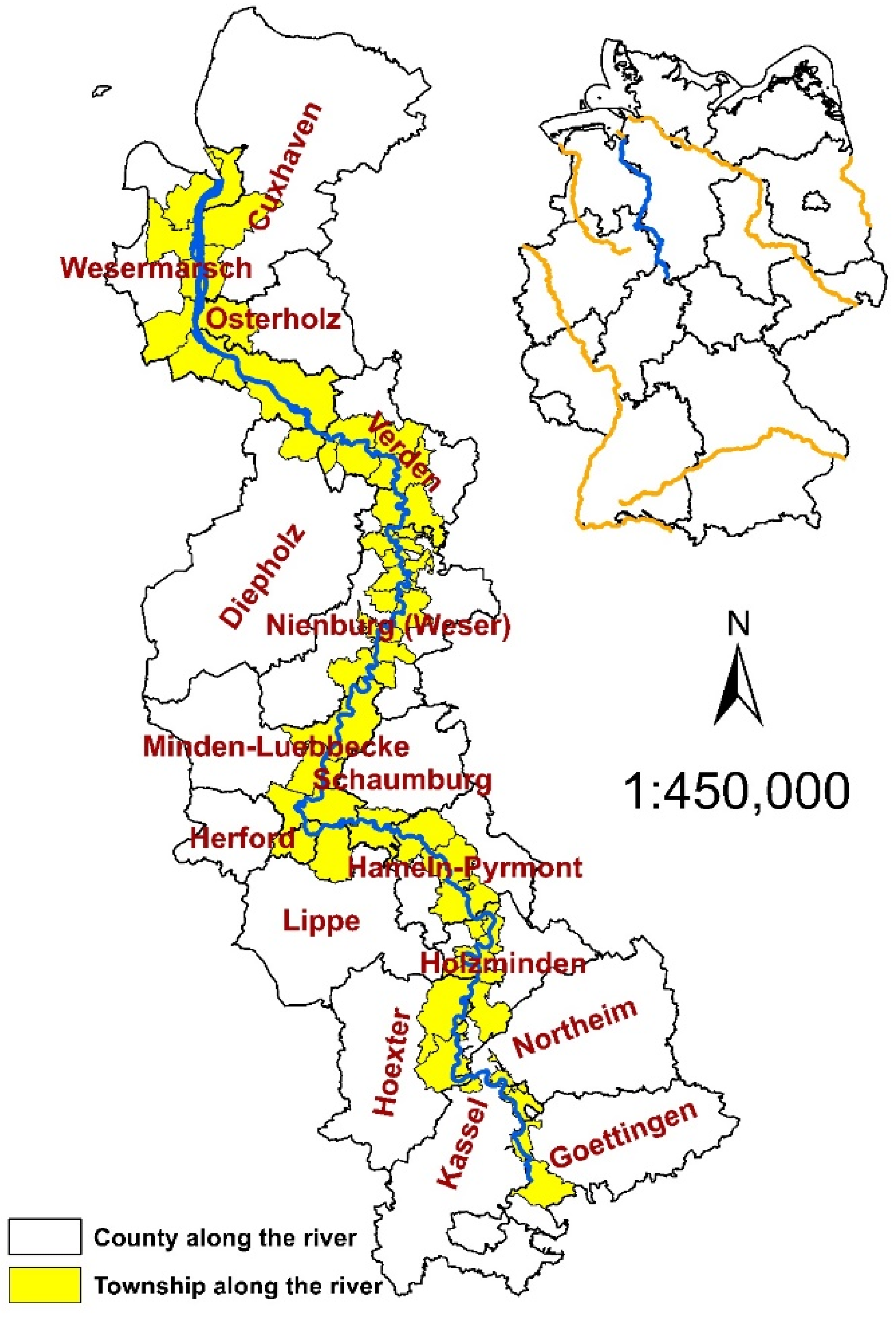
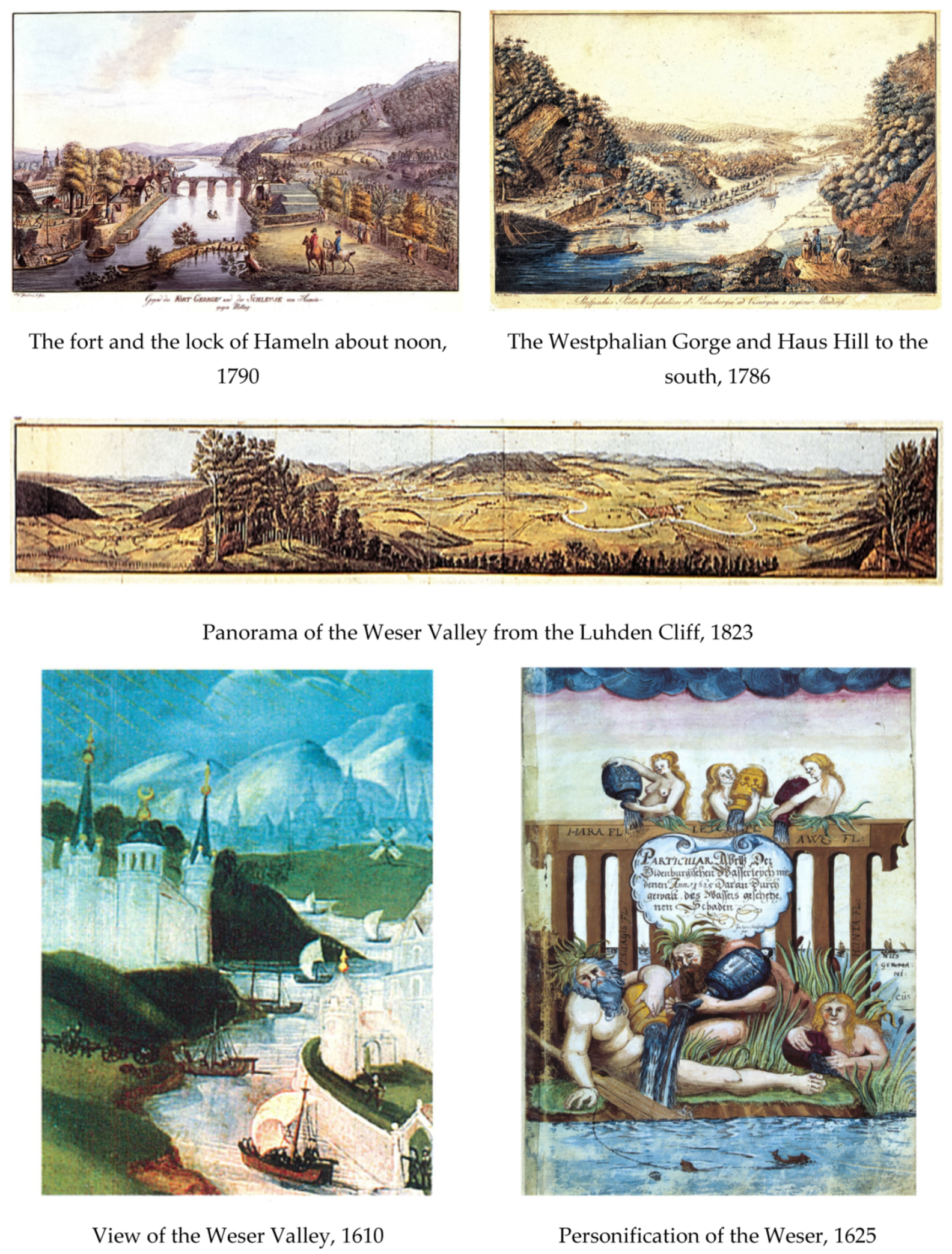
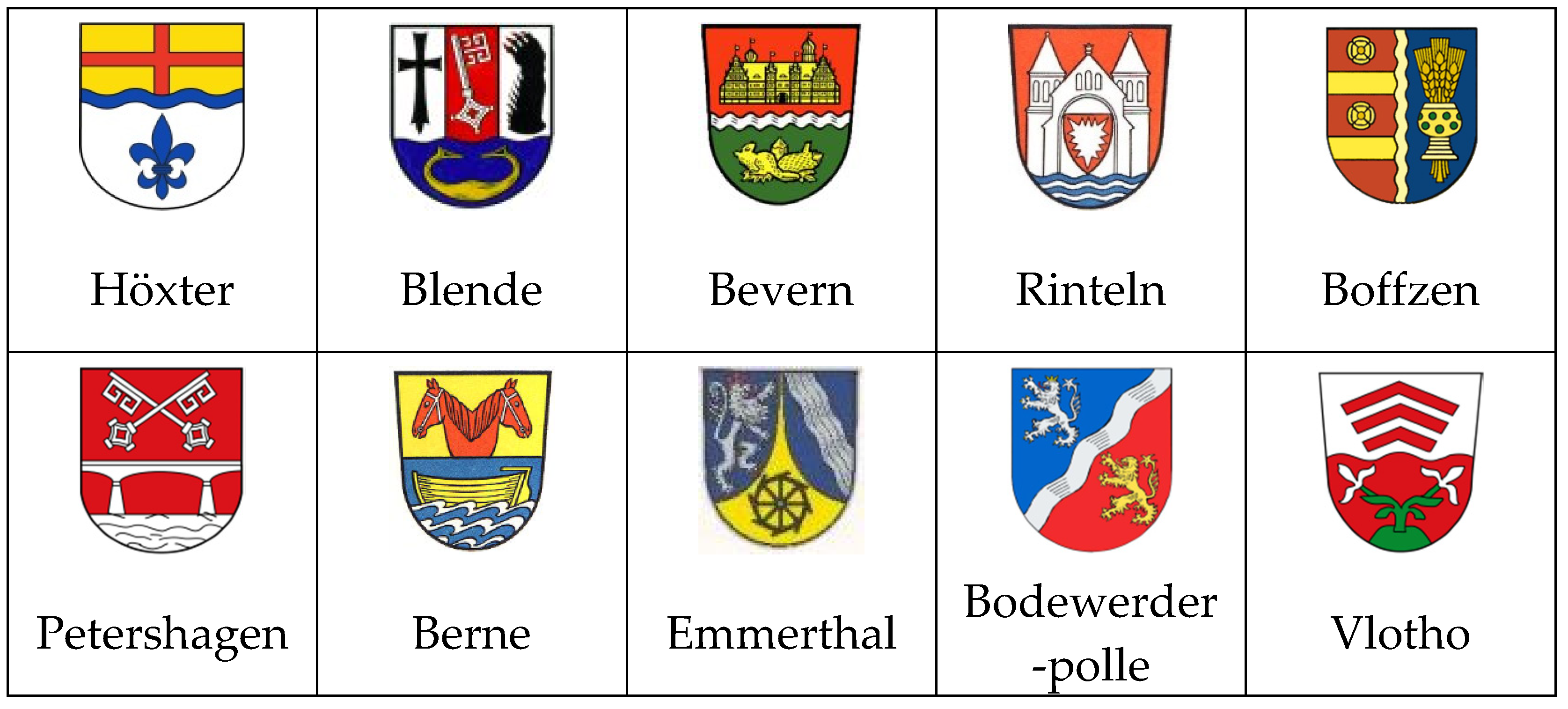
| Group | Class |
|---|---|
| Physical and experiential interactions | Physical use of land- or seascapes |
| Experiential use of land- or seascapes | |
| Intellectual and representative interactions | Science and education |
| Cultural Heritage | |
| Entertainment | |
| Inspiration | |
| Spiritual and emblematic interactions | Symbol |
| Sacredness and religiousness |
| Group | Class | Manifestation |
|---|---|---|
| Physical and experiential interactions | Physical use of land- or seascapes | Swimming areas, landing stages, camping sites, cycle routes |
| Experiential use of land- or seascapes | Viewing points | |
| Intellectual and representative interactions | Science and education | Museums |
| Cultural Heritage | Bridges, tunnels, ferries, canals, harbors, barrages, dikes | |
| Entertainment | Photographs | |
| Inspiration | Legends, poems, proses, novels, paintings | |
| Spiritual and emblematic interactions | Symbol | Coats of arms |
| Sacredness and religiousness | The whole or a part of the river, plants or animals living in the river |
| Place | Photograph |
|---|---|
| The Monument of Weser Song in Hannoversch Münden | 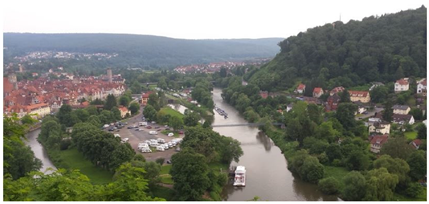 |
| The Skywalk of Hannoversche Cliff in Bad Karlshafen | 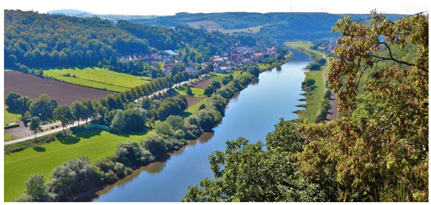 |
| The Monument of Kaiser Wilhelm in Porta Westfalica | 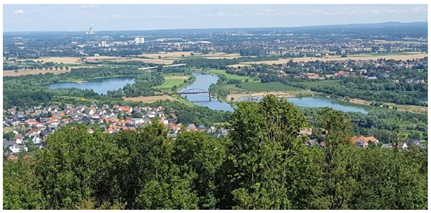 |
| Place | Folklore | Excerpt |
|---|---|---|
| Grohnde | The Trumpeter of Grohnde on the floating ice sheets | When the Trumpeter stepped from the warm room into the bright moonlight, he felt as if a mild wind was blowing. Or should that only be his heated blood? He hurried through the streets, came to the towpath, and looked over the Weser. A light flashed on the other side in Grohnde. Ah, in the hours of merriment, the Weser had come to life again. The thawing wind had licked the ice cover; the urgent flow had broken it into large slabs and driven the ambulant mass crashing to the North Sea. |
| Porta Westfalica | How did the Westphalian Gorge arise | Because lightning came down, split the mountain with terrible thunderclap and opened a gaping ravine, through which the water could flow out again like the smoke in the chimney. Slowly the hills rose from the floods again like islands, the fields and houses emerged, and the Weser returned to its bed. But its water flowed henceforth northward through the new notch, and thus the Westphalian Gorge arose. |
| Petershagen | The shepherd of Petershagen | A shepherd was grazing his herd on a green meadow near the Weser between Petershagen and Windheim. The sun sank and the moon came up with its stars, and the shepherd was still sitting on the bank hill by the river. There he was watching something on the river, floating closer, light as a feather in the wind. And shortly he saw a figure in the moonlight standing there on a drifting shell in the water. |
| Bremen | How was the Theisenrad Dike saved | As the gnawing water continued to rise and the whole protective wall was in danger, the guards let the bells of all towers ring. There ran the crowds of Bremers, men, women, children, and saw the whole mess: a large hole was torn in the dike. The surge forced itself into the rift and washed away the edges. The wild waves weltered already gurgling, moaning against the houses. In vain the workmen plunge the whole truckloads of timber, soil, stones, and junk into the gaping hole. The torrential floods carried away everything, and the misfortune became only worse. In this emergency, Bremers recalled the old promise, and a terrible word got around. First quiet, then louder people grumbled: “A person must in the Wall, or we all sink. Hey, councilors, give us the victim!” |
| Place | Genre | Excerpt |
|---|---|---|
| Hannoversch Münden | Poem | Where Werra and Fulda kiss They must atone their names, And here begins by this kiss German up to the sea the Weser River [40]. |
| The whole river | Prose | …, where the Weser flows, mid through beautiful, though not large mountains, over friendly, but not rich villages, without steamships and without three-master, but often fraught with an ark hanging a colorful pennant, on which blithe people sit and look out or sing out over the blue water toward the blue mountains [53]. |
| Holzminden | Novel | The young, just flowering leaf buds of the low shrubs are hung with dewdrops. Some early white and yellow flowers shine weakly from the beds in the dusky night. The old river rustles and grumbles under the wall of the garden. Leaning on the parapet against the river, the Monika Fichtner stands and looks out dreamily shyly over the mirror of the Weser, in which the stars and the great comet contemplate their a thousand times reflected the image [54]. |
Publisher’s Note: MDPI stays neutral with regard to jurisdictional claims in published maps and institutional affiliations. |
© 2021 by the authors. Licensee MDPI, Basel, Switzerland. This article is an open access article distributed under the terms and conditions of the Creative Commons Attribution (CC BY) license (https://creativecommons.org/licenses/by/4.0/).
Share and Cite
Jiang, W.; Marggraf, R. Making Intangibles Tangible: Identifying Manifestations of Cultural Ecosystem Services in a Cultural Landscape. Land 2022, 11, 26. https://doi.org/10.3390/land11010026
Jiang W, Marggraf R. Making Intangibles Tangible: Identifying Manifestations of Cultural Ecosystem Services in a Cultural Landscape. Land. 2022; 11(1):26. https://doi.org/10.3390/land11010026
Chicago/Turabian StyleJiang, Wei, and Rainer Marggraf. 2022. "Making Intangibles Tangible: Identifying Manifestations of Cultural Ecosystem Services in a Cultural Landscape" Land 11, no. 1: 26. https://doi.org/10.3390/land11010026
APA StyleJiang, W., & Marggraf, R. (2022). Making Intangibles Tangible: Identifying Manifestations of Cultural Ecosystem Services in a Cultural Landscape. Land, 11(1), 26. https://doi.org/10.3390/land11010026






